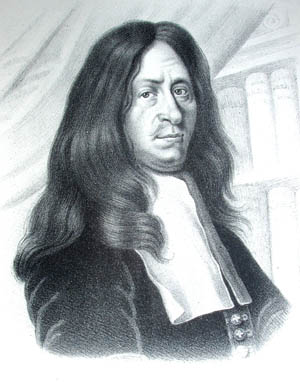Thomas Bartholin facts for kids
Quick facts for kids
Thomas Bartholin
|
|
|---|---|

Thomas Bartholin
|
|
| Born | 20 October 1616 |
| Died | 4 December 1680 (aged 64) |
| Nationality | Danish |
| Alma mater | University of Padua |
| Known for | Lymphatic system |
| Scientific career | |
| Fields | Medicine |
| Institutions | University of Copenhagen |
| Academic advisors | Johannes Walaeus |
Thomas Bartholin (born October 20, 1616 – died December 4, 1680) was a Danish doctor, mathematician, and theologian. He is most famous for discovering the lymphatic system in humans. He also helped develop the idea of using cold to numb pain, a method called refrigeration anesthesia. He was the first to describe this idea scientifically.
Thomas Bartholin came from a very smart family. Many members of his family became famous scientists. Twelve of them even became professors at the University of Copenhagen. For over 100 years, his family made important contributions to medicine and the study of the human body.
Contents
A Family of Scientists
Thomas Bartholin was the second of six sons. His father, Caspar Bartholin the Elder, was also a doctor. In 1611, his father published a very important book about human anatomy. Anatomy is the study of the body's structure.
Thomas later updated and improved his father's book. He added new information, like William Harvey's ideas about how blood moves around the body. Thomas also included his own discoveries about the lymphatic system.
His brother, Rasmus Bartholin, and his son, Caspar Bartholin the Younger, also made big contributions to medicine. For example, Caspar the Younger described the "Bartholin's glands".
Thomas's Life Story
Thomas Bartholin traveled a lot to study. He visited the Italian botanist Pietro Castelli in 1644.
In 1663, Thomas bought a farm called Hagestedgård. Sadly, in 1670, the farm burned down. His large library was destroyed, and he lost many important manuscripts.
King Christian V of Denmark helped Thomas. The King made him his personal doctor and gave him a good salary. He also made sure Thomas didn't have to pay taxes on his farm to help him recover from the loss.
In 1680, Thomas Bartholin became very ill. He sold his farm and moved back to Copenhagen. He died there and was buried in the Church of Our Lady.
Today, a street in Copenhagen called Bartholinsgade is named after his family. There is also the Bartholin Institute nearby. One of the buildings at the University of Aarhus is also named after him.
His Amazing Medical Discoveries
The Lymphatic System
In December 1652, Thomas Bartholin published the first full description of the human lymphatic system. This system is a network of tiny tubes that carry a fluid called lymph throughout the body. It's an important part of our immune system, helping to fight off sickness.
Other scientists, like Jean Pecquet and Olof Rudbeck, also made discoveries about the lymphatic system around the same time. This led to some arguments about who discovered it first. However, Bartholin's detailed description was very important.
Using Cold to Numb Pain
Thomas Bartholin also wrote about using cold to numb pain. This is called refrigeration anaesthesia. In his book, he mentioned that an Italian doctor named Marco Aurelio Severino was the first to use freezing mixtures of snow and ice in 1646. Thomas learned about this technique when he visited Naples.
Bartholin–Patau Syndrome
In 1656, Thomas Bartholin was the first to describe a condition called Bartholin–Patau syndrome. This is a serious condition that babies can be born with, caused by an extra chromosome.
Images for kids


